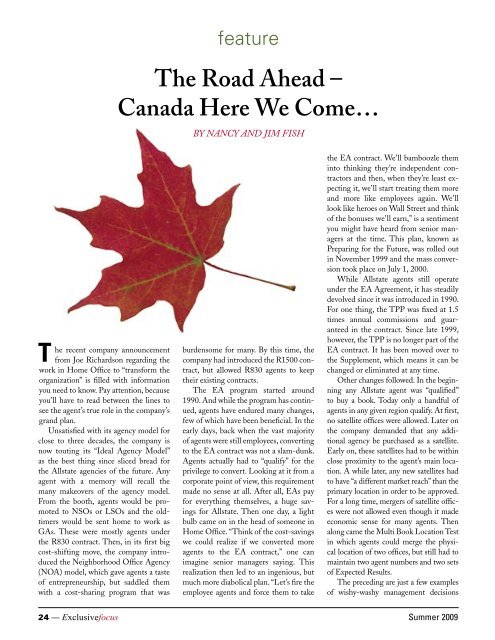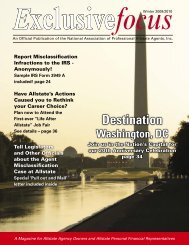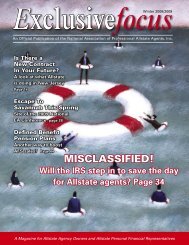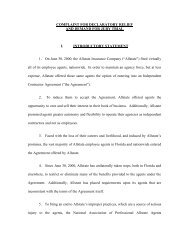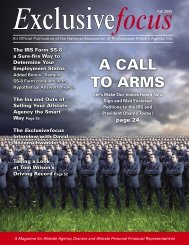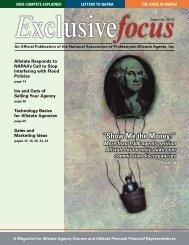Remembering Dick and Myra Larkin - National Association of ...
Remembering Dick and Myra Larkin - National Association of ...
Remembering Dick and Myra Larkin - National Association of ...
- No tags were found...
You also want an ePaper? Increase the reach of your titles
YUMPU automatically turns print PDFs into web optimized ePapers that Google loves.
featureThe Road Ahead –Canada Here We Come…BY NANCY AND JIM FISHThe recent company announcementfrom Joe Richardson regarding thework in Home Office to “transform theorganization” is filled with informationyou need to know. Pay attention, becauseyou’ll have to read between the lines tosee the agent’s true role in the company’sgr<strong>and</strong> plan.Unsatisfied with its agency model forclose to three decades, the company isnow touting its “Ideal Agency Model”as the best thing since sliced bread forthe Allstate agencies <strong>of</strong> the future. Anyagent with a memory will recall themany makeovers <strong>of</strong> the agency model.From the booth, agents would be promotedto NSOs or LSOs <strong>and</strong> the oldtimerswould be sent home to work asGAs. These were mostly agents underthe R830 contract. Then, in its first bigcost-shifting move, the company introducedthe Neighborhood Office Agency(NOA) model, which gave agents a taste<strong>of</strong> entrepreneurship, but saddled themwith a cost-sharing program that wasburdensome for many. By this time, thecompany had introduced the R1500 contract,but allowed R830 agents to keeptheir existing contracts.The EA program started around1990. And while the program has continued,agents have endured many changes,few <strong>of</strong> which have been beneficial. In theearly days, back when the vast majority<strong>of</strong> agents were still employees, convertingto the EA contract was not a slam-dunk.Agents actually had to “qualify” for theprivilege to convert. Looking at it from acorporate point <strong>of</strong> view, this requirementmade no sense at all. After all, EAs payfor everything themselves, a huge savingsfor Allstate. Then one day, a lightbulb came on in the head <strong>of</strong> someone inHome Office. “Think <strong>of</strong> the cost-savingswe could realize if we converted moreagents to the EA contract,” one canimagine senior managers saying. Thisrealization then led to an ingenious, butmuch more diabolical plan. “Let’s fire theemployee agents <strong>and</strong> force them to takethe EA contract. We’ll bamboozle theminto thinking they’re independent contractors<strong>and</strong> then, when they’re least expectingit, we’ll start treating them more<strong>and</strong> more like employees again. We’lllook like heroes on Wall Street <strong>and</strong> think<strong>of</strong> the bonuses we’ll earn,” is a sentimentyou might have heard from senior managersat the time. This plan, known asPreparing for the Future, was rolled outin November 1999 <strong>and</strong> the mass conversiontook place on July 1, 2000.While Allstate agents still operateunder the EA Agreement, it has steadilydevolved since it was introduced in 1990.For one thing, the TPP was fixed at 1.5times annual commissions <strong>and</strong> guaranteedin the contract. Since late 1999,however, the TPP is no longer part <strong>of</strong> theEA contract. It has been moved over tothe Supplement, which means it can bechanged or eliminated at any time.Other changes followed. In the beginningany Allstate agent was “qualified”to buy a book. Today only a h<strong>and</strong>ful <strong>of</strong>agents in any given region qualify. At first,no satellite <strong>of</strong>fices were allowed. Later onthe company dem<strong>and</strong>ed that any additionalagency be purchased as a satellite.Early on, these satellites had to be withinclose proximity to the agent’s main location.A while later, any new satellites hadto have “a different market reach” than theprimary location in order to be approved.For a long time, mergers <strong>of</strong> satellite <strong>of</strong>ficeswere not allowed even though it madeeconomic sense for many agents. Thenalong came the Multi Book Location Testin which agents could merge the physicallocation <strong>of</strong> two <strong>of</strong>fices, but still had tomaintain two agent numbers <strong>and</strong> two sets<strong>of</strong> Expected Results.The preceding are just a few examples<strong>of</strong> wishy-washy management decisions24 — Exclusivefocus Summer 2009


